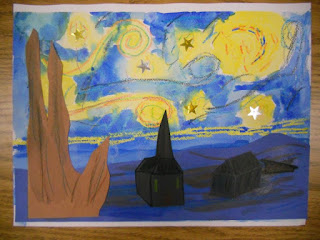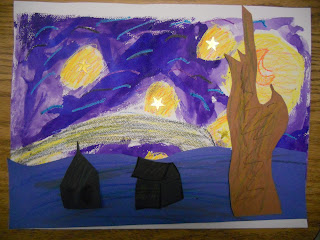 |
| The basic elements of a Starry Night: sky, buildings, hill, and tree. |
Poor Vincent sold very few paintings and drawings during his lifetime, because people of the 1890's didn't quite appreciate his vibrant colors. Today his paintings are some of the most famous and most beloved in the world (and sell for millions).
We looked closely at van Gogh's Starry Night and talked about our observations. We then had reproductions of the painting in front of us so we could see how van Gogh would create each section: sky, hill, tree, and buildings. Using the real painting as a guide allows the children to really see the work and bring their own pieces to another level. The children were required to use AT LEAST THREE COLORS in every section they were creating. That pushed them to think of color combos that would work for each section. Some of their color choices were amazing and inspiring.
Van Gogh-Inspired Starry Night
Supplies:
- Reproduction of van Gogh's "Starry Night"
- One 9" x 12" piece of watercolor paper
- Masking Tape
- Cardboard to tape the watercolor paper to
- Gold and silver star stickers
- Crayons
- Watercolor paints & brush
- Water bucket & paper towels
- Construction paper rectangles: Dark blue, 4 1/2" x 12"; Brown, 4" x 9"; Black, 4 1/2" x 6"
- Scissors
- Glue stick
Directions:
1. Tape the watercolor paper to the cardboard on all sides so that the paper doesn't buckle when wet.
2. Use the crayon to draw a moon on the watercolor paper. Make sure your crayon marks are nice a heavy because we'll be adding washes of watercolor and you want them to show up through the watercolor paint.
3. Put 5-6 silver and gold stars on the watercolor paper in the sky area.
4. Use your crayons to add swirls and dashes all around the moon and stars. Use "Starry Night" as reference. Use at least three colors in these light areas.
5. Use dashes in the dark "blue" area of the sky. Use at least three colors in this sky area. Don't color in the entire sky area with crayon, you'll be filling in the sky in the next step. Keep pressing firmly with the crayon.
6. Once your entire sky has all of the dashes and swirls you want on it, use watercolors to add a yellow glow around the stars and moon. If the yellow is too much for you, dab the paint on the paper with a piece of paper towel. Then add blue paint to the rest of the sky. You can blend the yellow and blue areas of the sky to make a bit of green (that seems to happen in van Gogh's piece). Cover the entire paper with watercolor. The bottom couple of inches will be covered by your construction paper hills, but you don't want to have a gap where the sky ends and your hills begin. Set the sky aside to dry.
7. Create the ground: grab your dark blue construction paper rectangle (4 1/2" x 12"). Use a dark crayon to draw the hills for your painting. Using additional crayons, add dashes of color (at least three colors!) to the hills. You can use a bit of watercolor in streaks as well, but don't soak the paper. Cut the hills out and set aside.
8. Create the cypress tree: grab your brown construction paper rectangle (4" x 9"). Use a dark crayon to draw the tree for your painting. Using additional crayons, add dashes of color (at least three colors!) to the tree. You can use a bit of watercolor in streaks as well, but don't soak the paper. Cut the tree out and set aside.
9. Create the buildings: same deal as steps 7 & 8 above, but use the black paper rectangle (4 1/2" x 6"). You can use at least three colors here as well. The watercolor streaks and crayon will show up on the back paper. I had the children do at least two buildings. Cut them out and set aside.
10. Once your background is dry, glue the hill, tree, and buildings to it.
WOW! You're done! Great job!




No comments:
Post a Comment